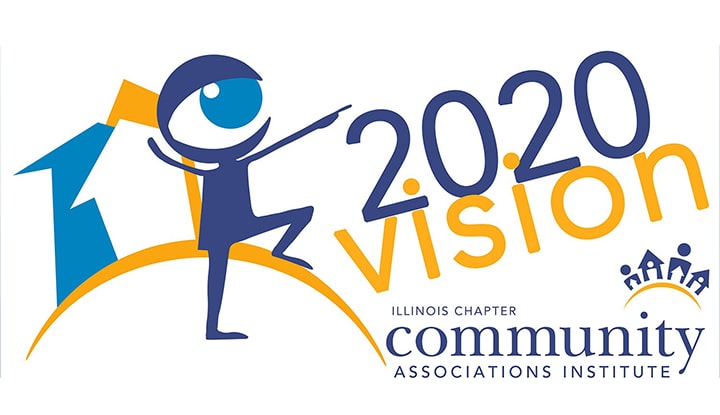On February 21st at the Donald E. Stephens Convention Center in Rosemont, this year’s CAI-IL Condo – HOA Conference & Expo will give you “2020 Vision” and offer education sessions on legal updates, innovative trends, hot topics, and industry best practices, as well as opportunities to share, learn, network, and discuss challenges and solutions.
Join more than 1,500 industry professionals and homeowner volunteer leaders – along with over 200 exhibitors – for the most comprehensive 1-day event for community associations in the state of Illinois!
Attendee RegistrationCurious about the kinds of courses you can expect to see at this year’s Conference & Expo? Here are a few of the many session options you’ll have to choose from!
Building Science: How to Manage Exterior Leaks
Presented by: Chris Kottra, Building Technology Consultants
Knowing the type of construction of your building envelope components and how they are affected by the exterior environment is the first step toward addressing leaks. This presentation will focus on the function and types of exterior wall assemblies, and how moisture moves through them. Steps on addressing water leakage issues will also be discussed.
Water leakage issues are all too common in community association buildings. Addressing those leaks can be a challenge. This educational session will cover some of the ways in which water can penetrate an exterior wall system and why that could be a bad thing.
Exterior walls serve as a protective barrier (i.e., from weather, fire, impact/blast, sound, intruders, etc.), an aesthetic feature, and a functional component affecting the performance of the building (i.e., energy consumption, daylighting, ventilation, etc.). Exterior walls can generally be divided into 2 categories: non-drainable and drainable. Non-drainable walls consist of barrier systems (i.e., conventional EIFS, single-wythe CMU, tilt-up precast concrete, some curtain wall systems, etc.), or absorptive walls (i.e., solid masonry, composite masonry, stone masonry, etc.). Drainable walls are constructed with a redundant water management system meaning there is a secondary drainage system behind the outer skin of the facade that redirects water back to the exterior. Examples of drainable exterior wall systems include cavity masonry construction, drainable stucco or EIFS, siding, and some curtain wall systems.
There are numerous mechanisms for moisture to move through walls, and not all walls are created equal. Therefore, there is not just one magical fix for every problem. Several steps should be taken to help ensure the leaks are addressed properly. The goal should be to treat the problem, not just the symptoms (avoid the band-aid approach). It is important to have the appropriate professionals involved to help identify the issue(s), diagnostically evaluate potential sources, and to recommend options for addressing the leaks. With the proper information in hand, the HOA’s Board will have the ability to make an educated decision to select an option that makes the most sense for the community going forward.
Repair or Replace? Spend Wisely on Roofing and Windows
Presented by: David Burke, Custom Installations – Phillip Mariotti, Woodland Windows & Doors
To fix or to replace, that is the question. When it comes to large capital expenses, roof and window replacements are near the top of the list when it comes to large purchases made by associations and homeowners. What is the typical life expectancy of a window? What about a roof? At what point in that life, is repair the right call and when is it time to replace?
In today’s world of throw away products, we think less and less about repairing our possessions and more and more about simply replacing them as a global world marketplace has driven down cost of comparable goods to the point that overall quality and durability have often been sacrificed.
When it comes to today’s’ roofing, and windows how do you decide what call to make? There are a few guidelines to keep in mind when it comes to assessment. First, what is the age of the roof and windows and how close are they to reaching their expected useful life? Material is important when it comes to life expectancy and so that is a good place to start. Vinyl windows typically have a shorter useful life expectancy than a fiberglass window, so it would be good to start with some research on the life expectancy of your product. By the same token the type of roof you originally purchased, ventilation, and weather conditions all play into the lifespan of your roof. Second, are the problems isolated, or prevalent throughout the building(s)? Isolated problems can typically be handled by repairs. For instance, if your double hung window no longer supports the sash from dropping down, than the counter balancers may need to be replaced for a relatively inexpensive repair. If you are experiencing a roof leak in one area of the building, again, the failure may be isolated into a particular area that can be possibly be patched or repaired. Lastly, if there is a desire for the quick short-term fix, than repair may be the solution. There are repairs that may expand the useful life of a product for 1-5 years, whereas a replacement would reset the useful life of the building element back to 40+ years. A repair may cost 25% the cost of replacement. Budgets are always a factor, but owners should also think big picture.
Make sure to catch this session for useful answers to help you determine whether it’s time to repair or replace.








